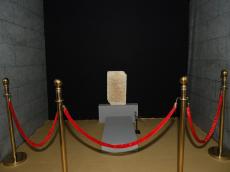|
|
TODAY.AZ / Arts & Entertainment
Karabakh khanate ruler's tombstone restored
21 June 2022 [17:32] - TODAY.AZ

By Azernews
By Laman Ismayilova
The National History Museum has enriched its collection with a unique exhibit.
The tombstone of the founder and first ruler of the Karabakh khanate, founder of Shusha city Panah Ali Khan Javanshir (1693-1763), is on display in the museum, Azernews reports, citing the Azerbaijan National Academy of Sciences.
Director-General of the Azerbaijani National History Museum, academician Naila Valikhanli, Vice-Presidents of the Azerbaijan National Academy of Sciences (ANAS), academicians Isa Habibbayli and Govkhar Bakhshaliyeva, Executive Director of the History Museum, associate professor Farhad Jabbarov, senior members of the Presidium of the Azerbaijan National Academy of Sciences (ANAS) took part in the presentation.
In her speech, Naila Velikhanly pointed out that the National History Museum has been systematically collecting, researching, and promoting a rich collection related to Karabakh history and culture.
She added that the exposition hall also displays a series of unique exhibits related to the history of Karabakh and the city of Shusha, including a 14th-century silver coin with an inscription about minting in Karabakh, two silver keys from the gates of the Shusha fortress, a mace - a symbol of the power of Ibrahimkhalil Khan (1763 -1806 years), rare documents, photographs, drawings, musical instruments, etc.
Academician Isa Habibbeyli stressed that this exposition is of great importance from the social, political and historical points of view.
He underlined that the History Museum provides insight into Azerbaijani history and culture through valuable exhibits and a number of events.
Academician Govkhar Bakhshaliyeva expressed her confidence that the museum exhibits related to the history of Karabakh and the city of Shusha, will become an important source for further research and studies.
Head of the Department of Scientific Exposition and Organization of Exhibitions, Ph.D. in history, associate professor, and curator of the exhibition Sabuhi Ahmadov noted that Panah Ali Khan Javanshir was buried at the Imarat cemetery in Aghdam, where a tomb was built over his grave.
During the Armenian occupation of Karabakh, most of the buildings there were destroyed, including monuments associated with Azerbaijan's prominent figures.
In 1974, the tombstone of Panah Ali Khan Javanshir was brought to the History Museum where it was restored using modern methods.
The museum's restoration laboratory restored the tombstone without damaging its original appearance.
On the first floor, the museum showcases a model of the "Imarat" cemetery and the translation of the inscription on the tombstone, information plates about the history of the tomb as well as Panah Ali Khan Javanshir's portrait by artist Ajdar Gafarov.
The National History Museum also plans to hold a special exhibition and catalog dedicated to the city of Shusha.
The opening of the exposition and the catalog presentation are scheduled for November this year.
URL: http://www.today.az/news/entertainment/221969.html
 Print version
Print version
Connect with us. Get latest news and updates.
See Also
- 16 January 2026 [14:34]
Opera Studio to hold concert in honor of national composer - 16 January 2026 [13:35]
Azerbaijan Cultural Center, Kokand State University discuss educational cooperation - 16 January 2026 [11:03]
Heydar Aliyev Palace marks Rashid Behbudov's 110th anniversary - 16 January 2026 [10:42]
Short historical documentary to be premiered at Nizami Cinema Center - 15 January 2026 [15:36]
Arts Council Azerbaijan transforms melodies into visual art - 15 January 2026 [15:06]
Virtuoso clarinetist celebrates his anniversary with gala concert - 15 January 2026 [13:35]
Winter Olympics 2026 to kick off with star-studded ceremony - 15 January 2026 [12:38]
Culture Ministry reviews citizens' appeals following meeting in Baku - 14 January 2026 [18:09]
ESC 2026: Azerbaijan secures spot in first half of second semi-final - 14 January 2026 [15:43]
Friendship on Silk Road: Azerbaijani, Uzbek artists unite in int'l online exhibition
Most Popular
 Fuel shortage has hit Yerevan - what prevents it from turning to Azerbaijan?
Fuel shortage has hit Yerevan - what prevents it from turning to Azerbaijan?
 Moscow must restrain its own mouthpieces like Solovyov.
Moscow must restrain its own mouthpieces like Solovyov.
 Baykar targets 25–30 P180 aircraft per year after Piaggio acquisition
Baykar targets 25–30 P180 aircraft per year after Piaggio acquisition
 China halts electricity imports from Russia as energy trade declines
China halts electricity imports from Russia as energy trade declines
 Amazon rolls out cloud service for European data sovereignty
Amazon rolls out cloud service for European data sovereignty
 Finland bans social media for under-15s
Finland bans social media for under-15s
 Dodge drops Hornet crossover amid weak sales
Dodge drops Hornet crossover amid weak sales
